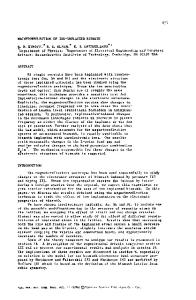Tribomechanical Properties of Ion Implanted Metals
- PDF / 1,470,171 Bytes
- 11 Pages / 417.6 x 639 pts Page_size
- 74 Downloads / 281 Views
TRIBOMECHANICAL PROPERTIES OF ION IMPLANTED METALS
IRWIN L. SINGER, Naval Research Laboratory, Code 6170, Washington, D.C. 20375
Chemistry Division,
ABSTRACT A review of tribomechanical studies supported by surface analysis finds ion implantation capable of increasing the sliding wear resistance of ion implanted metals in two ways. First, it can reduce+ friction by modifying the surface composition (e.g. Ti into steel) or by promoting the growth of low friction oxide layers (e.g. N into Ti). Second, it can modify the subsurface composition and structure to resist fracture and debris formation. These modifications harden the surface, change its work-hardening behavior and/or increase residual stresses. Microindentation hardness measurements indicate that many but not all of the wear resistant surfaces are hardened by implantation; thus, surface hardness is a contributing but not necessarily a controlling factor in wear resistance. These mechanisms of wear reduction and the chemical and microstructural modifications responsible for them are discussed. Evidence for wear reduction through the migration of N during wear is critically reviewed. It is concluded that the principal benefit of ion implantation is to prevent or delay the formation of wear particles, thereby changing the wear mode during run-in and permitting metals to reach load-carrying capacities up to their elastic limits.
INTRODUCTION Ion implantation has been highly touted by the material research community as a surface processing treatment for protecting metals against wear. So far, however, it has been regarded with healthy skepticism by many tribologists who are waiting for experimentally verifiable explanations of how a thin (100 nm) surface alloy can increase the wear resistance of metals. These explanations have been coming, slowly but steadily, from simple friction and wear tests supported by microscopic analyses of wear scars, and from surface analytical studies aimed at identifying the compositions and microstructures responsible for wear resistance. While these tests adequately describe the response of implanted layers to sliding contact, they are too crude to examine the tribomechanical properties of the thin (-100nm) implanted layer. More direct measures of these properties have been obtained from two very surface sensitive techniques, microindentation hardness and polishing wear studies. This paper reviews many of these studies and provides evidence for four mechanisms by which ion implantation improves the sliding wear resistance of metals. The second section describes two ways that ion implantation can affect sliding wear processes: it can alter the deformation behavior of a metal surface under stresses transmitted during sliding, and it can reduce the stresses transmitted. The third section examines the tribomechanical effects of Ti- and N-implantation on the friction and sliding wear behavior of selected metals. Studies involving high speed sliding have been excluded because of the uncertainties associated with heating effects. Surfa
Data Loading...









